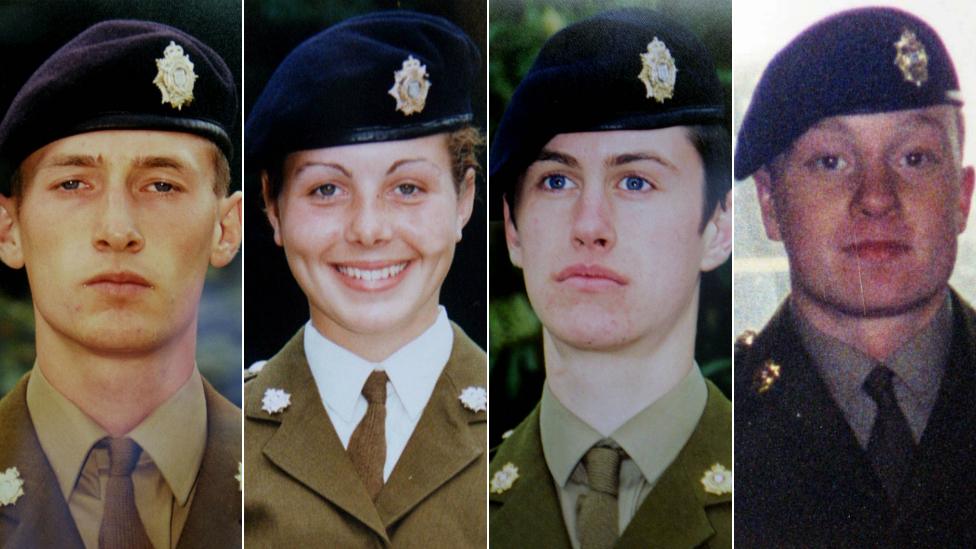Deepcut inquest: Soldier death 'soot marks' questioned
- Published

Pte Cheryl James was found dead with a bullet wound to the head
"Soot" deposits found on the face and thumb of a soldier who died at Deepcut barracks are "indicative" of a close gunshot wound, an inquest has heard.
Pte Cheryl James was found with a fatal head wound in November 1995.
Forensic ballistics expert Ann Kiernan ran experiments to simulate Pte James's injuries - which included a "stellate" skin tear - and soot deposits.
The tear and soot suggested the gun's muzzle was near her face, she said. She denied the marks could have been mud.
Pte James, 18, from Llangollen, Denbighshire, was one of four recruits to die at Surrey's Deepcut base in seven years.
'Weather damp'
Ms Kiernan, who conducted experiments using synthetic bone, skin and tissue and pig skin at various firing distances, told the inquest "the results obtained from pig belly skin is what I'd expect to see of gunshot wounds on human skin".
But Alison Foster QC, representing Pte James's family, questioned the validity of her conclusions, citing a report by pathologist Professor Derrick Pounder.
Ms Foster told the inquest the report queried the suggestion that markings on Pte James's thumb were caused by soot from an SA80 British Army Rifle, adding it could have been "mud, earth or soil."
She added the lack of an official weather report could limit the validity of the evidence, but Ms Kiernan said the "weather being damp does not necessarily mean there would be the presence of mud".
Questioned about the stellate tear, Ms Kiernan said these could be caused by long-distance shots but "soot would not be present".
She said: "The stellate tear and the presence of soot on the left hand suggest the muzzle was at close distance from the face."

The body of Pte Cheryl James was found near the perimeter fence
Prof Pounder, who was brought in by Pte James's family to provide an exhumation post-mortem last year, confirmed bullet fragments were recovered during the examination.
He said he did not believe there to be "soot on the face" and discussing the material on Pte James's thumb, he said he did not believe those marks to be soot either. He said: "I've always considered it to be dirt."
Prof Pounder said evidence from the scene was "quite compelling for a self-inflicted wound" with the weapon alongside the body and the muzzle below one of the hands.
But he added if the injury wasn't "self-inflicted", the only other possible scenario was the scene was in some way "staged".

Pte Cheryl James died in woods near the gate of Deepcut barracks
The inquest in Woking also heard from forensic pathologist David Rouse who was asked to assist with the case in 2002.
He said he had checked the rifle length and range of Pte James's arm, and found the rifle was short enough for Pte James to use it to "effect her own death".
Mr Rouse admitted he "couldn't say" if someone other than Pte James could have inflicted the wounds.
Dr Christopher Smith, who performed the post-mortem examination on Pte James in 1995, said he did not find "any sign of struggle".
He said: "Her undergarments had not been disturbed. I found no evidence of assault by a third party."
Dr Smith said he concluded the gunshot wound was self-inflicted because "the amount of destruction seemed to match".
An initial inquest into Pte James's death in 1995 recorded an open verdict, but that was overturned by the High Court which ordered the new hearing.
The hearing was adjourned.
Who were the Deepcut four? Background to the deaths and timeline of events.

Privates Benton, James, Gray and Collinson died at Deepcut between 1995 and 2002
- Published18 April 2016

- Published11 April 2016

- Published23 March 2016

- Published21 March 2016

- Published18 March 2016

- Published20 June 2019
